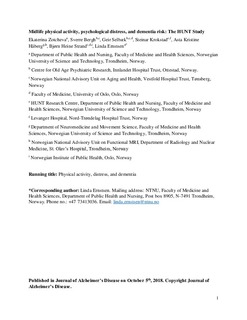Midlife Physical Activity, Psychological Distress, and Dementia Risk: The HUNT Study
Zotcheva, Ekaterina; Bergh, Sverre; Selbæk, Geir; Krokstad, Steinar; Håberg, Asta; Strand, Bjørn Heine; Ernstsen, Linda
Journal article, Peer reviewed
Accepted version
Permanent lenke
http://hdl.handle.net/11250/2582775Utgivelsesdato
2018Metadata
Vis full innførselSamlinger
Sammendrag
Background:
Physical activity (PA) is associated with a decreased dementia risk, whereas psychological distress (distress) is linked to an increased dementia risk.
Objective:
We investigated independent and joint associations of midlife moderate-to-vigorous PA (MVPA) and distress with incident dementia.
Methods:
Our study comprised 28,916 participants aged 30–60 years from the Nord-Trøndelag Health Study (HUNT1, 1984–1986). Data on MVPA and distress from HUNT1 was linked to the Health and Memory Study in Nord-Trøndelag for dementia case identification. Participants were followed from 1995 until 2011. We used adjusted Cox regression models to estimate hazard ratios (HRs) and 95% confidence intervals (95% CI).
Results:
In fully adjusted analyses, MVPA was associated with a reduced dementia risk (HR 0.81, 95% CI 0.62–1.06), compared to no MVPA. Distress was associated with an increased dementia risk (HR 1.30, 95% CI 0.99–1.70). Compared to distressed participants not taking part in MVPA, non-distressed no-MVPA participants had a reduced dementia risk (HR 0.72, 95% CI 0.54–0.96). The same applied to distressed MVPA participants (HR 0.50, 95% CI 0.22–1.14), and non-distressed MVPA participants (HR 0.63, 95% CI 0.44–0.90). Our results indicated an additive interaction between MVPA and distress on dementia risk.
Conclusion:
Our results suggest that midlife MVPA reduces risk of incident dementia among both distressed and non-distressed individuals.
